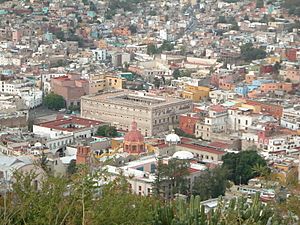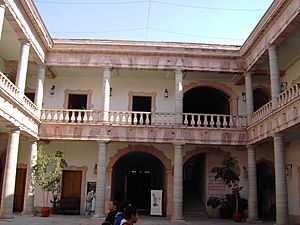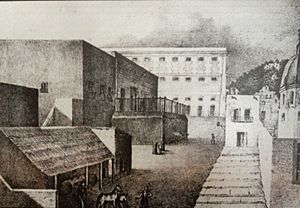Alhóndiga de Granaditas facts for kids
 |
|
| Lua error in Module:Location_map at line 420: attempt to index field 'wikibase' (a nil value). | |
| Established | 1958 |
|---|---|
| Location | Mendizabal 6, Historic District, Guanajauto, Guanajauto |
| Type | History museum |
The Alhóndiga de Granaditas is a very old building in Guanajuato City, Mexico. It was once a large warehouse for storing grain like corn and wheat. Today, it is known as the Regional Museum of Guanajuato.
This important building was built between 1798 and 1809. It was ordered by Juan Antonio de Riaño y Bárcena, a Spanish official. The name "Alhóndiga" means "grain market" or "warehouse" in both Arabic and Spanish.
The Alhóndiga became famous during the first battle of the Mexican War of Independence. Miguel Hidalgo y Costilla and his army attacked it. This battle led to the legend of el Pípila, a brave miner. In 1988, the building became a World Heritage Site as part of the Historic Town of Guanajuato.
Contents
Building Design
The Alhóndiga de Granaditas shows off Neoclassical style. This means it has a grand, simple design inspired by ancient Greek and Roman buildings. The first plans for the building were made in 1796.
The building is quite large, measuring about 72 by 68 meters. It stands 23 meters tall. It was built on the side of a hill, so two of its sides are surrounded by higher ground. The outside looks very strong, almost like a castle. It has simple windows and decorative edges called cornices. These are made from two types of local stone, one reddish and one greenish.
Inside, there is a large central courtyard. A covered walkway, called a porch, surrounds this patio. It has Tuscan columns, which are simple and strong. Two staircases lead to the upper floor. The building has only two main doors, one on the east and a larger one on the north.
The Alhóndiga was first used for buying and selling grains. Before Mexico became independent from Spain, it also served as a warehouse, a military base, and even a prison. Now, it is a regional museum.
A Look Back in Time
The Battle of the Grain Exchange
In 1810, Miguel Hidalgo y Costilla led an army of rebels. They wanted Mexico to be free from Spain. When they came to Guanajuato City, many Spanish people and rich locals hid inside the Alhóndiga. They thought the strong building would protect them. About 300 loyalists were inside, while 20,000 rebels surrounded the building.
The rebels attacked the building, throwing rocks. The Spanish leader, Riaño, died during this attack. This caused confusion among the defenders. The rebels then decided to burn down the eastern door to get inside.
A brave local miner named Juan José Martínez, also known as "El Pípila", was chosen for this dangerous task. Legend says he tied a large flat stone to his back. This stone protected him from bullets and rocks as he approached the door. He poured oil on the door and lit it with a torch.
Once the door burned down, the rebels rushed into the Alhóndiga. Everyone inside was killed, and the building was looted. It was a very violent day. This event made Hidalgo decide not to attack Mexico City. He worried his followers would repeat the looting and violence.
Later, the main rebel leaders, including Hidalgo, Ignacio Allende, Juan Aldama, and José Mariano Jiménez, were captured. They were executed, and their heads were cut off. These four heads were hung from the corners of the Alhóndiga. This was meant to scare anyone else who wanted independence. The heads stayed there for ten years until Mexico finally won its freedom. They were later moved to Mexico City.
In 1867, the Alhóndiga was turned into a prison by Emperor Maximilian. It remained a prison for almost 100 years.
Between 1955 and 1966, an artist named José Chávez Morado painted amazing murals inside the building. These murals show the important history of the place. In 1958, the Alhóndiga officially opened as a museum.
A Place for Everyone
Next to the Alhóndiga is a large plaza with wide steps. This area becomes a big outdoor stage during the yearly International Cervantino Festival. People can watch free music and dance shows from all over the world.
Inside the museum, you can find exhibits that honor the heroes of Mexican Independence. There is also a collection of Pre-Columbian art. This art was given to the museum by José Chávez Morado and his wife in 1975.
See also
 In Spanish: Alhóndiga de Granaditas para niños
In Spanish: Alhóndiga de Granaditas para niños
- List of buildings in Guanajuato City





